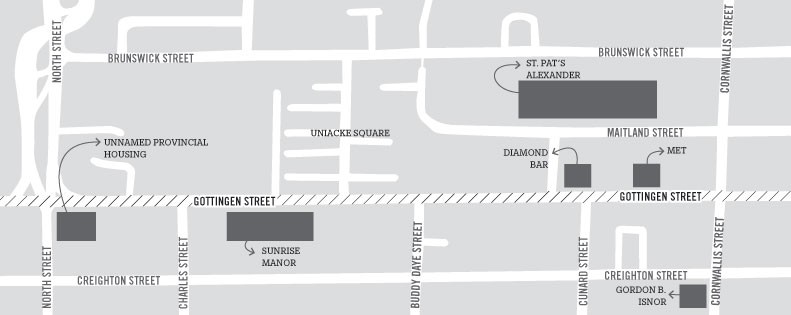Everyone agrees: too many low-income people can't afford a decent home in Halifax. So how come housing activists, developers and governments aren't producing new options? Part of the answer is that affordable housing is tossed like a hot potato between the province and city.
But the province has initiated talks with the city to determine how to work better together. "We're scoping out a lot of things, to develop something that hasn't been done: a provincial housing strategy," says minister of community services Denise Peterson- Rafuse. "We need to work with municipalities, whether bylaws need to be changed, and we'll do a public consultation in late fall."
Part of the province's "scoping" focuses on Gottingen Street. Connor Architects and Planners has been hired to design the rebuilding of Sunrise Manor and Gordon B. Isnor Manor, and to build on a nearby vacant lot, with all work to commence "in the very near future."
In comments to the city contained in a recent planning document, the architect complains that height limits on the sites are too onerous. "The form and density envisaged by the [province's] projects will need more than the five-six storeys as relates to the Sunrise property and the 10 storeys as relates to the Gordon B. Isnor property," reads the document. "The proposed projects will be mixed market and include unit sizes much smaller than those present in the market today and also include mixed use to accommodate other departments of the provincial government as well as retail and office spaces and will provide entry level housing solutions to first time home owners."
But others working to create affordable housing say the province has sometimes hampered more than helped, in part by denying them the ability to break the height limits that the province itself objects to.
Ross Cantwell, who sits on the board of the Housing Trust, says the inability of province and city to work together is stalling progress on 122 units for the working poor at the old MET Store and Diamond Bar sites on Gottingen. He says the city has resisted the trust's push to update the secondary municipal planning strategy. "It was last updated in late '90s. The height limits on Gottingen are 50 feet, and 40 feet for Maitland, which is 18 feet lower. If you built across it'd have a 28-foot drop."
Cantwell says after initially excellent support from the province in buying the properties, things have been stuck in limbo for two years: "We tore the old buildings down and rented the space out as parking to cover tax expenses, then got reassessed as commercial and our taxes tripled."
He says the provincial funding model provides a $25,000 subsidy per unit of affordable housing, whether the project is in rural Nova Scotia or downtown Halifax. "Here the land costs consume the entire subsidy. With height limitations we can't provide the 50 percent subsidy to make it work. And the heritage crowd rallies against anything higher. All we want is 10 floors."
As a result of that resistance, the province "refused to amend the HRM charter to allow density bonusing in the new Centre Plan." Meanwhile, construction costs go up five to seven percent annually, Cantwell says. "They've almost gone up as much as our subsidy. We're back at square one."
Peterson-Rafuse says the amendment was turned down to balance density, heritage and views of the harbour. "There was a lot of sensitivity around the convention centre. If I feel that needs to be revisited, I'll bring it forward."
Despite the delays, Housing Trust's plans remain: 244 units in two buildings, half affordable housing for working poor (with 20 reserved for "retired artists") and the other half market rates. But construction can't begin any earlier than fall 2013.
Other housing experts say the province should focus on existing housing stock. The president of the Investment Property Owners Association, Jeremy Jackson, recently told Herald columnist Roger Taylor that with 1,200 empty apartments in Halifax, the province could achieve affordable housing goals by directly subsidizing low-income renters to fill those units.
Heritage Trust's Phil Pacey cites the 2011 Halifax Rental Market Report by the Canada Mortgage and Housing Corporation. Units in buildings constructed before the year 2000 are 22 to 64 percent cheaper to rent.
"The cost of construction increases each year, increasing the cost of new housing," Pacey argues. "Older housing may have paid off its mortgage so the owners may be able to rent these properties for the cost of utilities, heat, maintenance and taxes."
Pacey fears that if zoning is changed to allow new, taller buildings, existing affordable housing stock could be lost. The 248-year-old Morris House, which was moved to Creighton and Charles Streets in May and is slated to provide nine affordable housing units, provides a case study on the marriage of heritage and affordable housing. Pacey and Jeremy Jackson both argue that affordable housing could be offered more cheaply using existing units.
Dalhousie Architecture's Grant Wanzel has also been at times frustrated with his encounters with the province. Wanzel is behind Gottingen Terrace, a planned 48-unit condo project that would allow people making $31,000 a year to own a home.
Gottingen Terrace has been in the works since 2009 with a couple dozen confirmed buyers. Last month Wanzel had to give up on the project as he had envisioned it. "We approached the province a couple times with proposals but they were turned down," he says, adding it's confusing that the province has now announced its intention to provide affordable ownership in the same area.
Wanzel eventually decided to go alone, without provincial support. He had the land, but needed construction financing and upfront costs. Another nonprofit---Wanzel won't say which---had the money. But it withdrew due to other priorities.
Wanzel pursued private financing, but it was too expensive to build units that lower-income families could afford. "We pulled the plug on Gottingen Terrace, number one, sent out refund cheques. But we're considering other models with developers, to provide some affordable housing on the site."
Wanzel wanted to provide something for the working poor, who often fall through the cracks between subsidized rental and market costs. "The Gottingen area has absorbed more than enough affordable rentals," he says. "You don't concentrate all affordable housing in one area; you need ownership."













